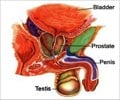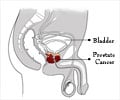The new fully-automated method to classify cancer versus non-cancer prostate tissue samples is supposed to bring on a revolution in cancer diagnosis.
Prostate cancer is the most common cause of death from cancer in men over age 75. It is also the third most common cause of death from cancer in men of all ages. Microscopic study of tissues remains as the gold standard of diagnosis of the cancer. Manual assessment of biopsy tissue limits speed and accuracy in clinical practice and research of prostate cancer diagnosis. A fully-automated microscopy method has been developed to distinguish cancerous from non-cancerous tissue samples. Researchers have reported to have achieved a very high accuracy using the new technique.
Biopsy is the only test that can confirm a diagnosis of prostate cancer. A small sample of tissue is taken through a fine needle and examined under a microscope to see if cells are cancerous. Biopsy is performed manually. This places a large demand on pathology services. Manual examination also limits speed and throughput. Histologic (microscopic) assessment is also critical to scientific progress as it is often the basis for research studies. Search for alternative methods that can alleviate workloads, assure quality control and reduce costs were on. Several efforts have been made to develop automated systems for the diagnosis and grading of microscopic prostate images.
The new fully-automated method to classify cancer versus non-cancer prostate tissue samples is supposed to bring on a revolution in cancer diagnosis. The new strategy involves the combined use of two microscopies-optical microscopy and IR (infrared) microscopy. One gives an idea about the structure while the other tells you about the chemical properties. The concept of combining microscopies is anticipated to lead to an accurate, robust and automated method for determining cancer within biopsy specimen.
Authors claim that the method is entirely transparent to a user. ‘By combining the IR and optical data, we achieved high accurate classification’, they report. The findings have been published in BioMed Central, a leading online publisher of scientific articles.
Source-BMJ






![Prostate Specific Antigen [PSA] Prostate Specific Antigen [PSA]](https://www.medindia.net/images/common/patientinfo/120_100/prostate-specific-antigen.jpg)







